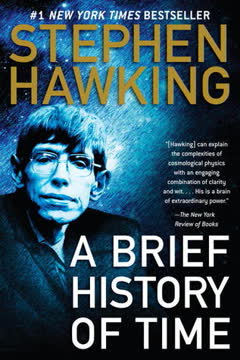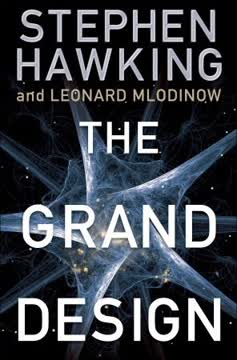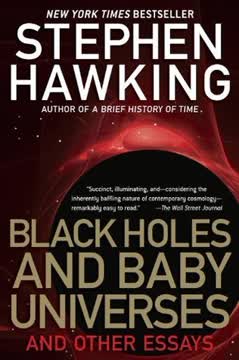Key Takeaways
1. Relativity Revolutionized Our Understanding of Space and Time
Einstein's postulate that the laws of nature should appear the same to all freely moving observers was the foundation of the theory of relativity, so called because it implied that only relative motion was important.
Challenging Absolutes. Einstein's theory of relativity shattered the long-held Newtonian concepts of absolute rest and universal time. The theory posits that the laws of physics, including the speed of light, remain constant for all observers, regardless of their relative motion. This revolutionary idea implied that time is not a universal constant but is relative to the observer's frame of reference.
Mass-Energy Equivalence. One of the most profound consequences of relativity is the equivalence of mass and energy, expressed in the famous equation E=mc². This equation reveals that a small amount of mass can be converted into a tremendous amount of energy, as demonstrated by nuclear fission. This principle has far-reaching implications, from nuclear power to the development of atomic weapons.
Curved Spacetime. Einstein's general theory of relativity further transformed our understanding of gravity, proposing that mass and energy warp spacetime. Objects move along the curves in spacetime, which we perceive as gravitational forces. This concept was confirmed by observations of the bending of light around the sun during a solar eclipse, marking a paradigm shift in our understanding of the universe.
2. Time Has a Shape, Influenced by Gravity and Quantum Mechanics
General relativity combines the time dimension with the three dimensions of space to form what is called spacetime.
Spacetime Fabric. General relativity merges time with the three spatial dimensions into a four-dimensional continuum called spacetime. The distribution of matter and energy in the universe warps and distorts this spacetime, causing objects to move along curved paths, which we perceive as gravity. This concept gives time a shape, inextricably linking it with space.
Imaginary Time. To reconcile general relativity with quantum mechanics, the concept of imaginary time is introduced. Imaginary time, a mathematical construct, behaves like another spatial dimension, offering a richer range of possibilities than the linear progression of real time. This concept is crucial for understanding the universe's origin and fate.
Black Hole Thermodynamics. The behavior of time near black holes reveals a deep connection between quantum gravity and thermodynamics. Black holes possess temperature and entropy, with entropy proportional to the area of the event horizon. This suggests that information about the quantum states within a black hole may be encoded on its boundary, hinting at the holographic principle.
3. The Universe's Origin and Fate Are Encoded in a "Nutshell"
The universe has multiple histories, each of which is determined by a tiny nut.
Multiple Histories. Quantum theory suggests that the universe does not have a single, definite history but rather a multitude of possible histories, each with its own probability. This concept, championed by Richard Feynman, implies that the universe explores every possible path, with our observed reality being just one realization.
No-Boundary Condition. To understand the origin of the universe, Jim Hartle and Stephen Hawking proposed the "no-boundary condition," suggesting that the universe has no boundary in space and time. In imaginary time, the universe's history is a closed surface, like a sphere, eliminating the need for initial conditions or external causes.
Anthropic Principle. The anthropic principle states that the universe must be as we observe it because if it were different, we would not be here to observe it. This principle helps explain why certain fundamental constants and physical laws are fine-tuned for the existence of life. It also suggests that our existence as intelligent beings restricts the possible histories of the universe.
4. Black Holes Challenge Our Ability to Predict the Future
Penrose and I showed that general relativity predicted that time would come to an end inside a black hole, both for the star and for any unfortunate astronaut who happened to fall into it.
Event Horizons and Information Loss. Black holes, regions of spacetime with gravity so strong that nothing, not even light, can escape, pose a significant challenge to determinism. The event horizon, the boundary of a black hole, marks the point of no return. Anything that crosses the event horizon is lost to the outside universe, potentially including information.
Hawking Radiation. Quantum theory predicts that black holes are not entirely black but emit thermal radiation, known as Hawking radiation. This radiation carries away energy, causing the black hole to slowly evaporate over time. However, the radiation appears to be random and uncorrelated with the information that fell into the black hole, leading to the "information paradox."
P-Branes and Information Retrieval. String theory offers a potential resolution to the information paradox by suggesting that black holes are composed of p-branes, extended objects in higher dimensions. Information about what falls into a black hole may be stored as waves on these p-branes and eventually re-emitted as the black hole evaporates, preserving determinism.
5. Time Travel Faces Hurdles, Protected by Physical Laws
I can prove that to build a finite time machine, you need negative energy.
Wormholes and Time Loops. Einstein's theory of general relativity opens the possibility of time travel through wormholes, hypothetical tunnels connecting different points in spacetime. However, the existence of time loops, closed timelike curves that allow travel to the past, raises paradoxes, such as the grandfather paradox.
Chronology Protection Conjecture. To address these paradoxes, Stephen Hawking proposed the Chronology Protection Conjecture, which suggests that the laws of physics conspire to prevent macroscopic time travel. This conjecture implies that any attempt to create a time machine would be thwarted by physical effects, such as the accumulation of infinite energy densities.
Negative Energy Requirement. Building a finite time machine requires negative energy, a concept that violates classical physics but is allowed by quantum theory. However, the amount of negative energy needed and the instability of time loops make macroscopic time travel highly improbable, supporting the Chronology Protection Conjecture.
6. Complexity in Biological and Electronic Life Will Continue to Increase
The world has changed far more in the last hundred years than in any previous century.
Exponential Growth. The human population, electricity consumption, and scientific knowledge have all experienced exponential growth in recent centuries. This rapid increase in complexity cannot continue indefinitely, raising questions about the future of our civilization.
Biological Evolution. Life on Earth has evolved from simple organisms to complex beings through the process of natural selection acting on random mutations in DNA. The development of written language and external information storage has accelerated the rate of cultural and technological evolution.
Genetic and Electronic Enhancement. The future may see humans enhancing their biological and electronic capabilities through genetic engineering and advanced computing. This could lead to a divergence from the Star Trek vision of a static future, with humans evolving into beings far more complex and intelligent than we are today.
7. M-Theory Suggests We May Live on a Brane or Be Holograms
If quantum gravity incorporates the holographic principle, it may mean that we can keep track of what is inside black holes.
Extra Dimensions. M-theory, a candidate for the theory of everything, proposes that spacetime has ten or eleven dimensions, with the extra dimensions curled up at a subatomic level. This theory suggests that our universe may be a brane, a higher-dimensional object embedded in a larger space.
Holographic Principle. The holographic principle suggests that the information content of a region of space can be encoded on its boundary, like a hologram. This principle may apply to the universe as a whole, implying that our three-dimensional reality is a projection from a two-dimensional surface.
Implications for Reality. If the holographic principle is correct, it would revolutionize our understanding of reality, suggesting that what we perceive as the fundamental building blocks of the universe are merely projections from a more fundamental level. This concept challenges our intuitive notions of space, time, and information.
8. The Quest for a Unified Theory Continues
In 1 9 8 8 , when A Brief History of Time was first published, the ultimate Theory of Everything seemed to be just over the horizon.
Unifying Gravity and Quantum Mechanics. One of the greatest challenges in modern physics is to reconcile general relativity, which describes gravity, with quantum mechanics, which governs the behavior of matter at the atomic and subatomic levels. A unified theory of quantum gravity is needed to understand the universe at its most fundamental level.
M-Theory as a Candidate. M-theory is a promising candidate for a unified theory, incorporating all five consistent versions of superstring theory and eleven-dimensional supergravity. However, M-theory is still incomplete, and many of its properties remain mysterious.
The Ongoing Journey. The quest for a unified theory is an ongoing journey, with many challenges and unanswered questions. Despite the difficulties, the pursuit of knowledge and understanding continues to drive scientific progress, pushing the boundaries of human understanding.
Last updated:
FAQ
What is "The Universe in a Nutshell" by Stephen Hawking about?
- Explores Modern Physics: The book provides an accessible overview of the most important concepts in modern physics, including relativity, quantum mechanics, and cosmology.
- Focus on Big Questions: Hawking addresses fundamental questions about the nature of the universe, time, black holes, and the possibility of time travel.
- Visual and Conceptual Approach: The book uses illustrations, analogies, and minimal mathematics to explain complex scientific ideas to a general audience.
- Updates Since "A Brief History of Time": It serves as a follow-up to Hawking’s earlier work, incorporating new discoveries and theories developed since 1988.
Why should I read "The Universe in a Nutshell" by Stephen Hawking?
- Understand Cutting-Edge Science: The book distills the latest advances in theoretical physics and cosmology in a way that is approachable for non-experts.
- Learn from a Renowned Physicist: Stephen Hawking is one of the most influential scientists of our time, and his insights offer a unique perspective on the universe.
- Engaging and Visual: The book is filled with original illustrations and creative analogies that make abstract concepts more tangible.
- Stimulates Curiosity: It encourages readers to think deeply about the origins, structure, and fate of the universe, as well as humanity’s place within it.
What are the key takeaways from "The Universe in a Nutshell" by Stephen Hawking?
- Relativity and Quantum Theory: The universe is governed by two fundamental theories—general relativity and quantum mechanics—which are not yet fully reconciled.
- The Shape and Origin of Time: Time may have a specific shape and could have begun with the big bang, possibly without a boundary.
- Multiple Histories and the Anthropic Principle: The universe may have multiple possible histories, and our existence is tied to the conditions that allow intelligent life.
- Black Holes and Information: Black holes are not completely black; they emit radiation and raise questions about the loss of information and determinism.
- The Future of Humanity: Advances in science and technology will continue to accelerate, potentially leading to new forms of life and intelligence.
How does Stephen Hawking explain relativity and quantum theory in "The Universe in a Nutshell"?
- Relativity’s Impact: Hawking explains how Einstein’s theories of special and general relativity revolutionized our understanding of space, time, and gravity.
- Quantum Mechanics: The book covers the basics of quantum theory, including the uncertainty principle and the probabilistic nature of reality.
- Incompatibility Issue: Hawking discusses the ongoing challenge of unifying relativity and quantum mechanics into a single theory of quantum gravity.
- Historical Context: The development of these theories is presented through the lives and work of key scientists like Einstein, Planck, and Heisenberg.
What is the "shape of time" according to "The Universe in a Nutshell" by Stephen Hawking?
- Time as a Dimension: General relativity combines time with the three spatial dimensions to form spacetime, which can be curved by mass and energy.
- Imaginary Time Concept: Hawking introduces the idea of imaginary time, a mathematical construct that allows for new models of the universe’s origin.
- No Boundary Proposal: The book suggests that the universe may have no boundary in imaginary time, making the beginning of time a regular point rather than a singularity.
- Implications for Creation: This approach removes the need for a creator or a moment of creation, as the universe could be self-contained.
How does "The Universe in a Nutshell" by Stephen Hawking describe the origin and fate of the universe?
- Big Bang and Expansion: The universe began with the big bang and has been expanding ever since, as supported by astronomical observations.
- Multiple Possible Histories: Quantum theory implies the universe doesn’t have a single history but a range of possible histories, each with its own probability.
- Anthropic Principle: The conditions we observe are those that allow for the existence of intelligent life, influencing which histories are relevant.
- Possible Futures: Depending on the amount of matter and vacuum energy, the universe could end in a big crunch, expand forever, or accelerate due to dark energy.
What are black holes, and what new insights does "The Universe in a Nutshell" by Stephen Hawking provide about them?
- Black Holes Defined: Black holes are regions of spacetime where gravity is so strong that nothing, not even light, can escape.
- Hawking Radiation: Hawking discovered that black holes emit radiation due to quantum effects, meaning they can eventually evaporate.
- Information Paradox: The book discusses the puzzle of whether information that falls into a black hole is lost forever, challenging the principle of determinism.
- Holographic Principle: Hawking explores the idea that information about what falls into a black hole may be stored on its surface, hinting at a holographic nature of reality.
Is time travel possible according to "The Universe in a Nutshell" by Stephen Hawking?
- Wormholes and Time Loops: The book examines the theoretical possibility of time travel via wormholes or closed timelike curves in spacetime.
- Chronology Protection Conjecture: Hawking proposes that the laws of physics may prevent time travel on a macroscopic scale, protecting the past from paradoxes.
- Quantum Effects: Quantum fluctuations and negative energy are required for time machines, but practical and stability issues likely prevent their construction.
- Microscopic Time Travel: While quantum theory allows for time travel on a microscopic scale, it is not useful for traveling back to change history.
What is M-theory, and how does "The Universe in a Nutshell" by Stephen Hawking explain its significance?
- Unification of Theories: M-theory is presented as a framework that unites the five different string theories and eleven-dimensional supergravity.
- Extra Dimensions: The theory suggests the universe has more than four dimensions, with the extra ones being curled up or hidden.
- Branes and P-branes: M-theory introduces objects called branes, which can have various dimensions and may form the fabric of our universe.
- Ongoing Mystery: Hawking acknowledges that M-theory is still incomplete, likening it to a jigsaw puzzle with missing pieces in the center.
What is the holographic principle, and how is it discussed in "The Universe in a Nutshell" by Stephen Hawking?
- Information Storage: The holographic principle suggests that all the information within a region of space can be encoded on its boundary surface.
- Black Holes as Holograms: Hawking relates this principle to black holes, where the entropy (information content) is proportional to the area of the event horizon.
- Implications for Reality: This idea leads to the possibility that our three-dimensional universe may be a projection from information stored on a two-dimensional boundary.
- Predicting the Future: The principle is crucial for resolving the black hole information paradox and understanding the limits of predictability in physics.
How does "The Universe in a Nutshell" by Stephen Hawking address the future of humanity and intelligence?
- Exponential Growth: Hawking discusses the rapid, exponential increase in human population, knowledge, and technological capability.
- Genetic and Electronic Evolution: The book predicts that humans may soon be able to redesign their DNA and that artificial intelligence will surpass biological intelligence.
- Limits and Challenges: There are physical and practical limits to growth, such as energy consumption and the speed of light, but complexity will continue to increase.
- Uncertain Future: Hawking suggests that the future will be radically different from today, with new forms of life and intelligence, rather than a static, perfected society.
What are the best quotes from "The Universe in a Nutshell" by Stephen Hawking and what do they mean?
- "I could be bounded in a nutshell and count myself a king of infinite space." — Shakespeare, quoted by Hawking to illustrate how a small, finite universe can contain infinite possibilities.
- "God does not play dice." — Einstein’s famous objection to quantum randomness, discussed by Hawking to highlight the probabilistic nature of the universe.
- "Our quest for discovery fuels our creativity in all fields, not just science." — Hawking emphasizes the importance of curiosity and the ongoing journey of scientific exploration.
- "We shall increase in complexity, if not in depth, and shall always be the center of an expanding horizon of possibilities." — Hawking’s optimistic view of humanity’s future and the endless potential for growth and discovery.
Review Summary
The Universe in a Nutshell received mostly positive reviews, with readers praising Hawking's ability to explain complex concepts in an engaging manner. Many found the book thought-provoking and appreciated its updated content. However, some readers struggled with the complexity of certain topics, despite Hawking's efforts to simplify them. The book's illustrations were generally well-received, though a few found them confusing. Overall, readers valued the book for its insights into theoretical physics and cosmology, even if they didn't fully grasp all the concepts.
Similar Books


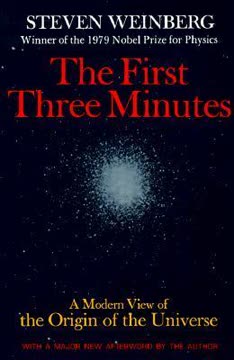


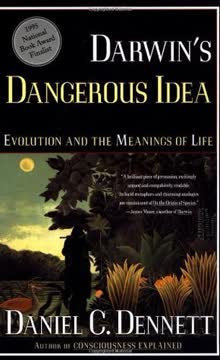
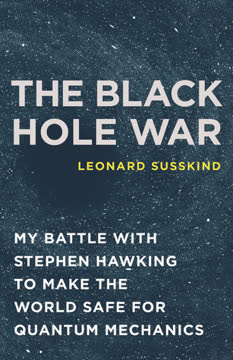



Download PDF
Download EPUB
.epub digital book format is ideal for reading ebooks on phones, tablets, and e-readers.

